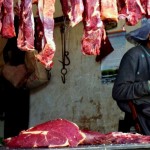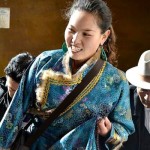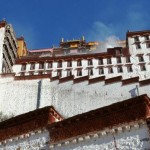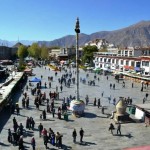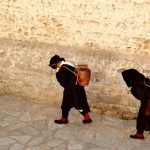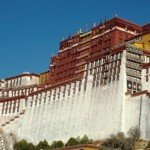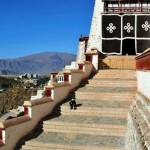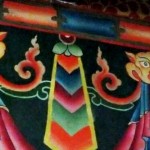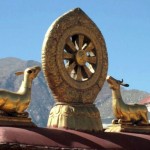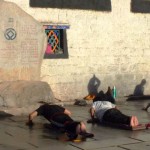Seven days in Tibet – episode 6
LHASA
The second day begins with a visit at the Potala Palace. From home, the guide informs us that our group is booked and the time we have is limited to only one hour. Insufficient time for even a small part of the 1.000 rooms and 10.000 altars. No more wondering what happen if we stay longer, we are clear about how the job is here, now. This strictly program, the image of the waving Chinese flags on the palace stop, the restriction to take pictures and the entrance screening like in the airport, concern me that I could quickly visit a cold museum. And I mellowed the revolutionary momentum of some of my mates.
The Red Palace, central, is dedicated to the study, meditation and resting for mummified bodies of 8 of the former Dalai Lamas, including the golden stupa of the 5th, the founder of the palace and of the 13th’s one, the most impressive, but inaccessible to the public, like many other treasures of the palace. Stupas and altars, covered in tons of gold and hundreds of thousands of precious stones, murals and sacred texts are housed in rooms divided into several wings connected by dark corridors. The heart of the red palace is the Holy Chapel, connected since the seventh century through a narrow and vertical passage with Dharma’s cave, where Songtsan Gampo meditated, the king who brought Buddhism to Tibet. Such places I saw, so I’m anxious to see where and how lived during the winter whose have incarnated the Buddha of Compassion. That White Palace. It seems that at least insight is very far from the notion of one palace. Austere, dark, steep, intimate. Even the rooms devoted to meetings with the leaders of the world look like crossing hallways. I am glad to find here what I expected. I would linger all day, but Chinese rules are not negotiable.
Viewed from the rock base, Potala is really imposing. With the 117m height, divided into 13 floors and the 400m in diameter, the palace was for centuries the tallest building in the world. Total rises to over 300m above the city. And because Lhasa is situated already at 3.650m altitude, you should start to walk to the palace an hour before your schedule. No other reason, but you bring no improvement.
- Șapte zile în Tibet – Lhasa
- Șapte zile în Tibet – Lhasa
- Șapte zile în Tibet – Lhasa
- Șapte zile în Tibet – Lhasa
- Șapte zile în Tibet – Lhasa
- Șapte zile în Tibet – Lhasa
- Șapte zile în Tibet – Lhasa
- Șapte zile în Tibet – Lhasa
Although UNESCO rules, in whose heritage is, oppose to this, the palace adjoinsa few hundred meters with a much higher relay than it. The Chinese do anything to eliminate the building’s greatness. The huge market having in front a marble obelisk, the park with its’ artificial lake and the access ramps for auto back accessare collages designed to destroy an authentic Tibetan painting. Even so, thousands of people pass by every day the holy place, spinning andsurrounding the thousands prayer wheels, hopingfor better days. I join thiskora, but inadvertently in reverse, emphasizing the most embarrassing moment of my staying in Tibet. Hardly you can take pictures of the palace ensemble without any artifact such lanterns, Chinese gates, mast with red flag orany Chinese bombs scare soldier. Literally. I scare myself when a soldier turns angry at me, gesturing and shouting incomprehensible words. I departed the backpack and left two steps down into the middle market, which annoys him even more. Finally, I understand that I pose as a threat of bombing.
By the rule “no city without a rickshaw ride”’, we go to the hotel, from where we plan the departure to Jokhang Temple which I gave yesterday circling. We rediscover the old neighborhood’s Barkhor with its continue bustle. In front of the temple, dozens of people are doing their prayers, polishing stone tiles with their bodies. I capture as discrete as possible and I appreciate their strength, in this country become so hostile to them. The Jokhang – House of Shakyamuni Buddha – is a new Buddhism course having the entrance ticket printed with a 3D image of the temple. We can hardly be careful because of the crowd and the air increasingly difficult to breathe, the stenchsmell of burning yak hardly makes even the monks to wear cloth masks.
You can’t but don’t inhale the history of the most holy temple of Tibet, which have started from the seventh century. Legend says that it is built over a rippling lake which you can hear if you listen carefully to the very narrow end of the tunnel that reaches into the depths. Bad luck, however, it is now blocked by objects thrown by the curious who wanted to know how deep it is. The settlement houses sacred statues and other relics brought as dowry by the two wives, one Chinese and one Nepali, of the same Songtsan Gampo, the first king of Tibetan Empire. Architecture has Indian, Chinese and Nepalese influences, more obvious to me on the terrace of the temple where I unconsciously photogolden dragons, dharma wheels and view of the Potala and of the surrounding mountains. We leave the temple with pieces of the Jowo Rinpoche statue garments, the most venerated statue of the Tibetans, blessed, they say, by the Buddha himself. And with sanctified wheat, good for bedsides’ patients.
It is time for good food in one of the top roofrestaurants, installed on roofs of buildings that border the square in front of the temple. Of course, watched carefully by the service snipers. My first food bites remain pretty in my throat, while I feel the eyes of soldiers from across the building, looking for me. But drinking barley wine, the yak begins to feel at ease. We introduce to the Tibetan cats, who are reincarnations of fire-breathing dragons. How else to survive to its meals,formed from our remaining extremely spicy yak barbecue?
- Șapte zile în Tibet – Lhasa
- Șapte zile în Tibet – Lhasa
- Șapte zile în Tibet – Lhasa
- Șapte zile în Tibet – Lhasa
- Șapte zile în Tibet – Lhasa
- Șapte zile în Tibet – Lhasa
- Șapte zile în Tibet – Lhasa
- Șapte zile în Tibet – Lhasa
- Șapte zile în Tibet – Lhasa
I finished the second day in Lhasa doing some shopping for home and a new show of secular pilgrimage. I enjoy every moment and I try not to lose any frame from everything that happens around me. I’m surprised again about the diversity of faces and clothes scroll in front of me as a podium under the red lights of sunset. Smoke from that four fireplaces designed as astupaformat,where the juniper is burning,surrounds the crowd. Feelingsthese images induce me, will remain among those I will remember with great love.





